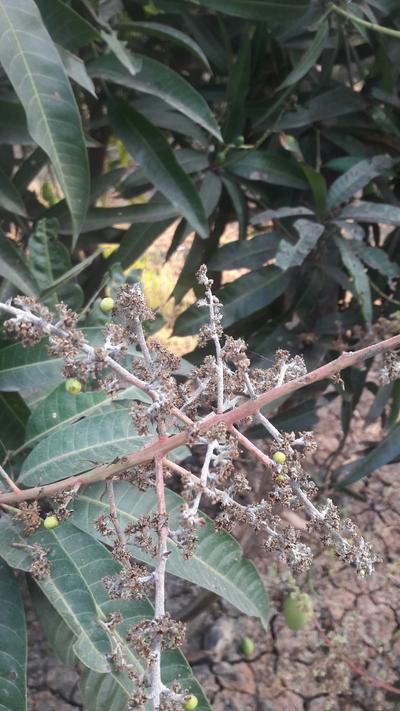Powdery Mildew of Mango
Oidium mangiferae
Fungus
In a Nutshell
- White, powdery patches on leaves, flowers and fruit.
- Leaf and fruit deformation.
Can also be found in
Symptoms
Infected plant parts show small patches of characteristic white, powdery fungal growth. At a later stage of the disease, the mildew can cover large areas of tissue. Older leaves and fruits might display a purplish-brown cast. Young leaves and flowers may be completely covered with white fungal spores, become brown and dry, and eventually die off. They can also show deformation, e.g. curling downwards. Fruits can be covered by whitish powder and in early stages they may crack and exhibit corky tissue. Infected fruits remain small and deformed, and do not reach maturity.
Recommendations

Organic Control
Spraying with bio-fungicides containing Bacillus licheniformis reduces powdery mildew infections. The parasitic fungus Ampelomyces quisqualis has been proven to suppress its development. Treating the plants with foliar sprays based on sulfur, carbonic acid, neem oil, koanin and ascorbic acid can prevent severe infection. Furthermore, milk is a natural fungicide. It can be applied in the form of whey to control powdery mildew.

Chemical Control
Always consider an integrated approach with preventive measures together with biological treatments if available. Fungicides containing monopotassium salts, hydrodesulfurized kerosene, aliphatic petroleum solvent, mancozeb and myclobutanil can be used to treat powdery mildew on mangos. For optimal effect, the treatment should start before flowering or at very early flowering stages. Continuous applications at regular intervals of 7-14 days are recommended.
What caused it?
The pathogen survives between seasons on old leaves or in dormant buds. Young tissue of all tree elements except for the stem and the roots are highly susceptible to the fungus. When favorable conditions are met, spores are released from harbored pathogens under the leaves or in the buds and are spread to other trees by wind or rain . Warm diurnal temperatures between 10-31°C and low nocturnal temperatures, combined with a relative humidity of 60-90%, are favorable conditions.
Preventive Measures
- Choose more tolerant or resistant varieties if available.
- Grow mango trees on dry and well-ventilated areas.
- Prune plants and remove tall weeds to reduce the incidence of the fungus.
- Intercrop with other non-host tree species.
- Ensure balanced nutrition and avoid high nitrogen fertilization.
- Remove infected plant parts and destroy any plant residues.
- Treat the plants with fertilizers containing potassium-phosphate.



